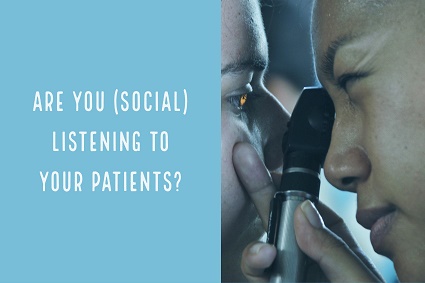Your cart is currently empty!

Learning from Patient Social Media
What can you learn from patients’ social media posts? A surprising amount. Social listening to patient social media can give you important action steps, if you know what to look for.
Studies of patient social media
For example, an article last fall in Academic Radiology reported that women’s tweets about their mammograms focused on three topics:
- “Breast compression” — the process of a mammogram involves squishing the breast tissue in a machine, and women (especially first timers) often wrote about their concerns about this, their experience of it, and how it wasn’t as bad as they expected.
- Encouraging other women to have a mammogram
- The importance of screening mammography for women’s health
Together, these three topics make up about 60% of all the tweets researchers found on the subject.
The remaining tweets included a wide range of topics, from worrying about the exam to the coffee served in the waiting room, the cost of the exams to their interactions with technicians.
Lead author Dr. Andrew Rosenkrantz told interviewers from radiology site AuntMinnie that their social listening experience convinced them that social media could be an excellent form of outreach to women. With so many women already serving as cheerleaders in social media, this is a reasonable conclusion. The data also suggests that women continue to be nervous about mammograms — saying that the experience was not as bad as they expected was very common. The level of relief shows that women are unnecessarily fearful about the pain of mammograms. Maybe it’s time to address that issue directly.
Social listening
A quick analysis of current Twitter conversations on some other medical topics found different patterns:
- Discussions about allergies are nearly 100% complaints such as, “My allergies are literally killing me!” or “Allergies, go away!”
- Discussions of concussions largely focus on sports gossip. There are lots of jokes and little medical information.
- Posts about zika from patients are rarely in English. Posts in English typically are informational posts from healthcare organizations.

Use social listening tools or just search with a hashtag to get a sense of the kinds of concerns and misconceptions your patients may have about specific topics. You can also see topics where sharing information would be a valuable service.
Patient messages
Check your Facebook page or the comments at your blog posts (blogs were the first social media, and they often still serve as social media now) to see specific concerns. This kind of data is more specific to your practice — but can also come from much smaller sizes of data samples. It’s easy to see one or two comments and get the feeling that your patients in general share a particular concern.
All three sources of health-related social media data can give you topics for your blogger, help you identify concerns you should address in your newsletter, and alert you to information you should be highlighting with patients.
Naturally, you should be careful in your replies to patient messages. Saying, “I’ll be calling you to talk directly about your concern” is often a good answer. But you can also provide blog posts that treat the subject more broadly and refer patients to that information. Doing so can save you and your team lots of time.
Consider adding social listening to your weekly to-dos — or contact us and let us take care for it for you.
by
Tags:

Leave a Reply